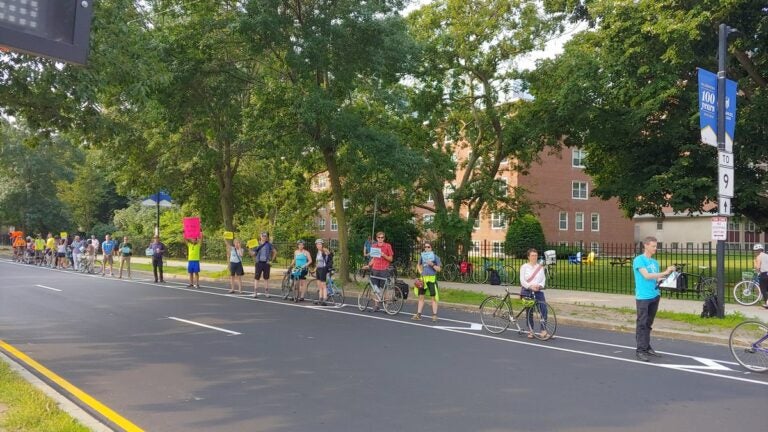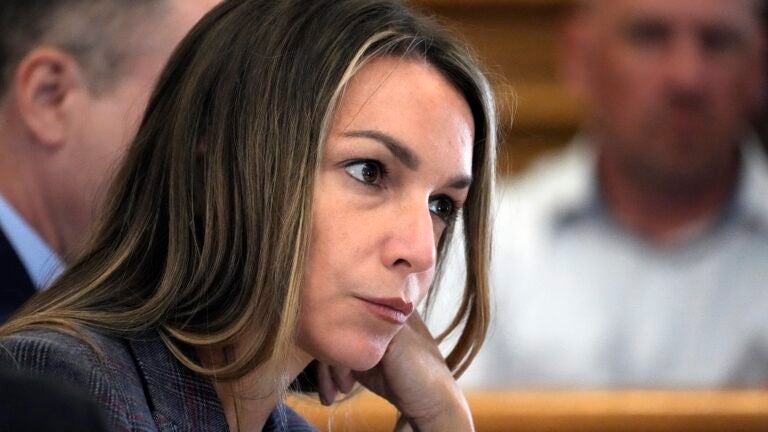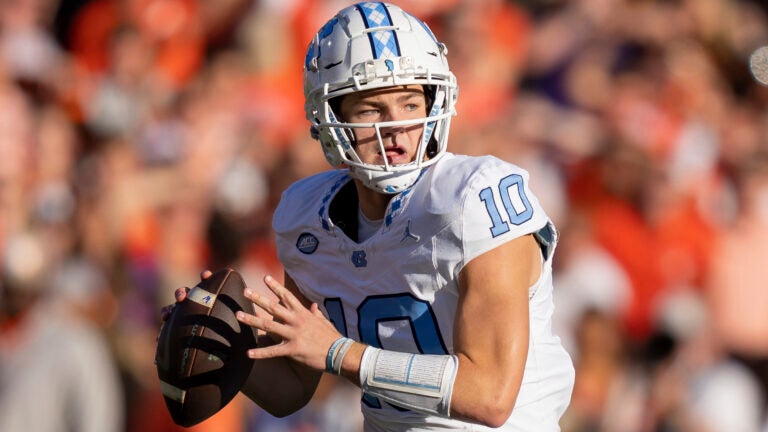Cyclists form a human ‘bike lane’ to protest plans in Fenway
State officials added bike lanes to two busy Boston parkways. Cyclists say the lanes need to be protected, and used their bodies to make the point.

Cyclists protested plans to install painted bike lanes near a Fenway intersection where a local librarian was killed in February by staging a “people-protected bike lane” Thursday morning.
“We can do better than just paint,” the Boston Cyclists Union, which organized the protest, wrote in a tweet.
We can do better than just paint. This morning, we are giving commuters what they should have everyday – physical separation from cars. @MassDCR can help us have this all the time. #ProtectedBikeLanesSaveLives#bospoli #mapoli pic.twitter.com/NJNxbviwZr
— BostonCyclistsUnion (@bostonbikeunion) July 11, 2019
The 8 a.m. demonstration consisted of more than 100 people standing in the roads near the intersection of Fenway and Brookline Avenue during the busy morning commute to “highlight the dangerous conditions cyclists face every day when given no protection beyond paint,” according to the union. Advocates independently staged a similar protest on the Congress Street bridge in 2017, which was a first for Boston at the time.
Becca Wolfson, the executive director of the Boston Cyclists Union, said Thursday morning that the event received so much interest they formed two “people-protected bike lanes” of roughly 50 people each: one where a bike lane is being painted on Fenway from Brookline Avenue toward Avenue Louis Pasteur and one in a northbound vehicle lane on Brookline Avenue between Park Drive and Fenway.
The fact that so many supporters mobilized on two days notice — the union announced plans for the demonstration on Tuesday — is “indicative of how important the issue is to people,” Wolfson said.
Well, a few people showed up in response to our call for an 8am people protected bike lane….#ProtectedBikeLanesSaveLivves #bospoli #mapoli pic.twitter.com/5vzan1q6yl
— BostonCyclistsUnion (@bostonbikeunion) July 11, 2019
In fact, so many people showed up to help create a people protected bike lane, we needed to create two.#ProtectedBikeLanesSaveLives#bospoli #mapoli pic.twitter.com/qOosIWnIgE
— BostonCyclistsUnion (@bostonbikeunion) July 11, 2019
Amazing turn out this morning to protect people who bike + demand #ProtectedBikeLanes. Thanks @bostonbikeunion for organizing! #ProtectedBikeLanesSaveLives pic.twitter.com/F4wsBSRBCS
— Elena Pilar (@elenita_pilar) July 11, 2019
I am a flexpost pic.twitter.com/23dCtDyDFs
— George S (@noisecapella) July 11, 2019
The protest is the first in what’s planned to be a continued campaign calling for physically separated bike lanes in the Boston area — specifically highlighting challenges their efforts have run into with the Massachusetts Department of Conservation and Recreation.
While the Department of Transportation manages most state-owned roads, DCR has jurisdiction over the parkways running along many of the state’s parks and green spaces. According to Wolfson, the difference is that DCR doesn’t have the same resources or policy standards when it comes to bike infrastructure as the City of Boston or MassDOT (both of which have specific guidances regarding separated bike lanes, even if Wolfson has criticized their level of urgency on the issue).
DCR is installing painted bike lanes on Park Drive and Fenway along the Emerald Necklace between Brookline Avenue and Avenue Louis Pasteur. According to Wolfson, the new bike lanes involved removing one of the three vehicle lanes on Fenway and narrowing the two vehicle lanes on Park Drive. The union still believes it’s a “dangerous set up.”
“Despite the painted bike lanes, we still saw many cyclists on the sidewalk, who told us they don’t feel safe riding in the area,” the group wrote in a Facebook post Wednesday, along with photos of the newly striped lanes.
https://www.facebook.com/bostoncyclistsunion/photos/pcb.344649236215274/2927047767324860/?type=3&theater
https://www.facebook.com/bostoncyclistsunion/photos/pcb.344649236215274/2927047670658203/?type=3&theater
Neither parkway had any sort of bike lanes before, but the bike union says protected or separated lanes should be the “norm” for DCR projects in the region. According to Wolfson, the agency has said it lacks the capacity — in terms of financial resources, equipment, and staffing — to construct and maintain physically separated lanes. Still, the union points to studies showing that separated lanes, while more expensive, dramatically reduce the risk of injury and death for bikers and pedestrians.
“We’re concerned that their lack of capacity to do enough will put people in more danger,” Wolfson told Boston.com.
DCR officials say the painted lanes were a way of swiftly incorporating bike infrastructure into a larger roadway resurfacing effort in the Fenway area. The $650,000 project spans 1.5 miles of roadway and is on pace to be finished later this month. According to the agency, the project — particularly the removal of a Fenway travel lane — amounts to a significant improvement for cyclists, while also maintaining the needed vehicle flow for commuters, medical personnel, and visitors to the local hospitals, colleges, museums, and Fenway Park.
The bike union, however, remains unassuaged.
In a press release, the advocacy group said DCR’s decision was “particularly unsettling” following the death of Paula Sharaga, a Cambridge resident and Brookline librarian. In February, Sharaga was hit and killed by a cement truck while biking to work through the five-way intersection where Park Drive and Brookline Avenue meet. Colleagues said the 69-year-old was an “avid cyclist.”
“If Paula were here, she would say, ‘Don’t mourn: Organize, and make sure this doesn’t happen to anyone else,'” Todd Kaplan, a friend of Sharaga, said during her “ghost bike” ceremony in February.
The bike union’s DCR-focused campaign won’t end in Fenway. The next location for potential demonstrations is the Arborway rotary in Jamaica Plain. Wolfson says the stretch was the site of 177 accidents in a recent 18-month span and is “in desperate need of an overhaul.”
People-protected bike lanes first came to Boston in December 2017, after city officials washed away an impromptu, spray-painted bike lane on the Congress Street bridge. One was also staged last year in Porter Square in Cambridge, and they’ve been formed across the country — including San Francisco, New York City, and Philadelphia — by cyclists in an attempt to make the point that painted lines do not provide enough protection from vehicles, particularly on busy streets.
In a similar demonstration this past spring, cyclists in Boston, Cambridge, and Newton placed lines of red Solo cups along the painted striping that divides bike lanes from the vehicle lanes to show how cars often encroach on their territory. Many of the cups were crushed.







